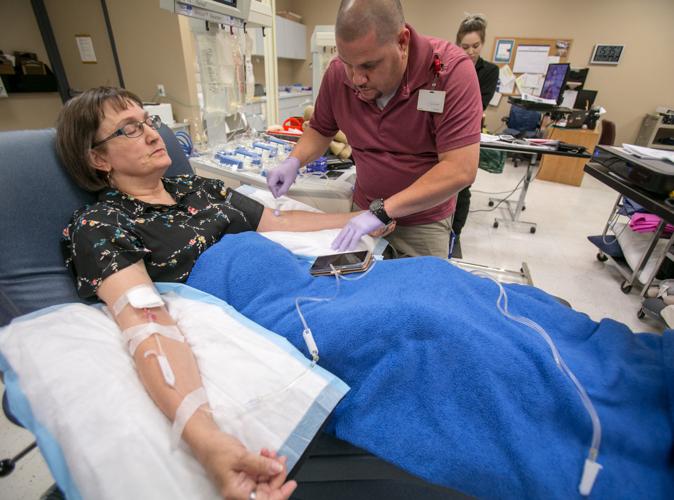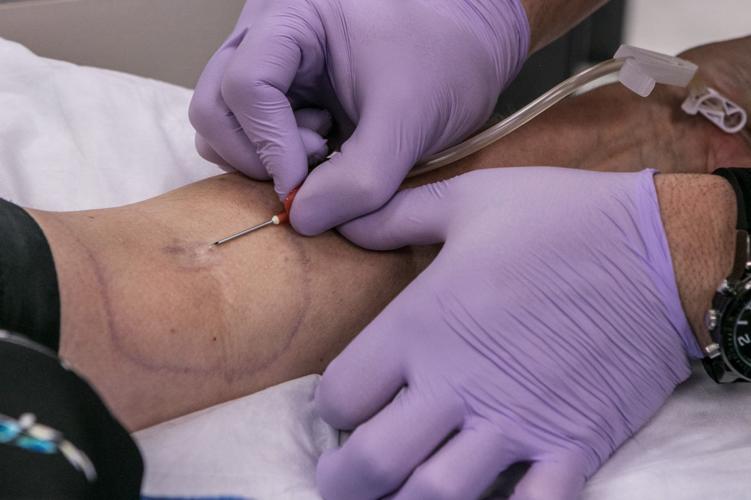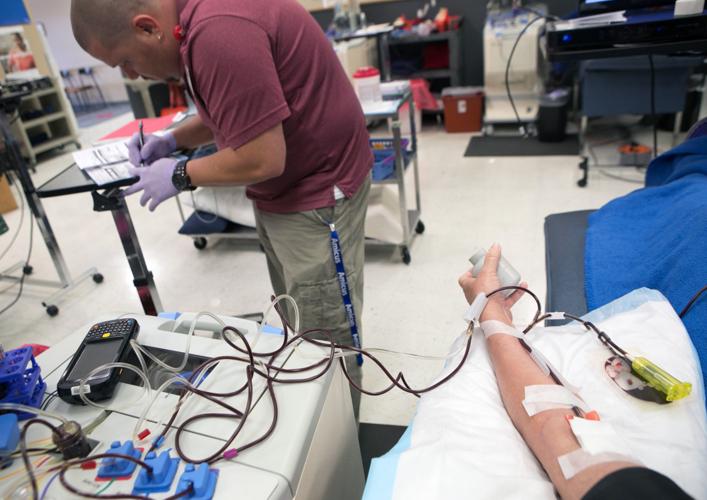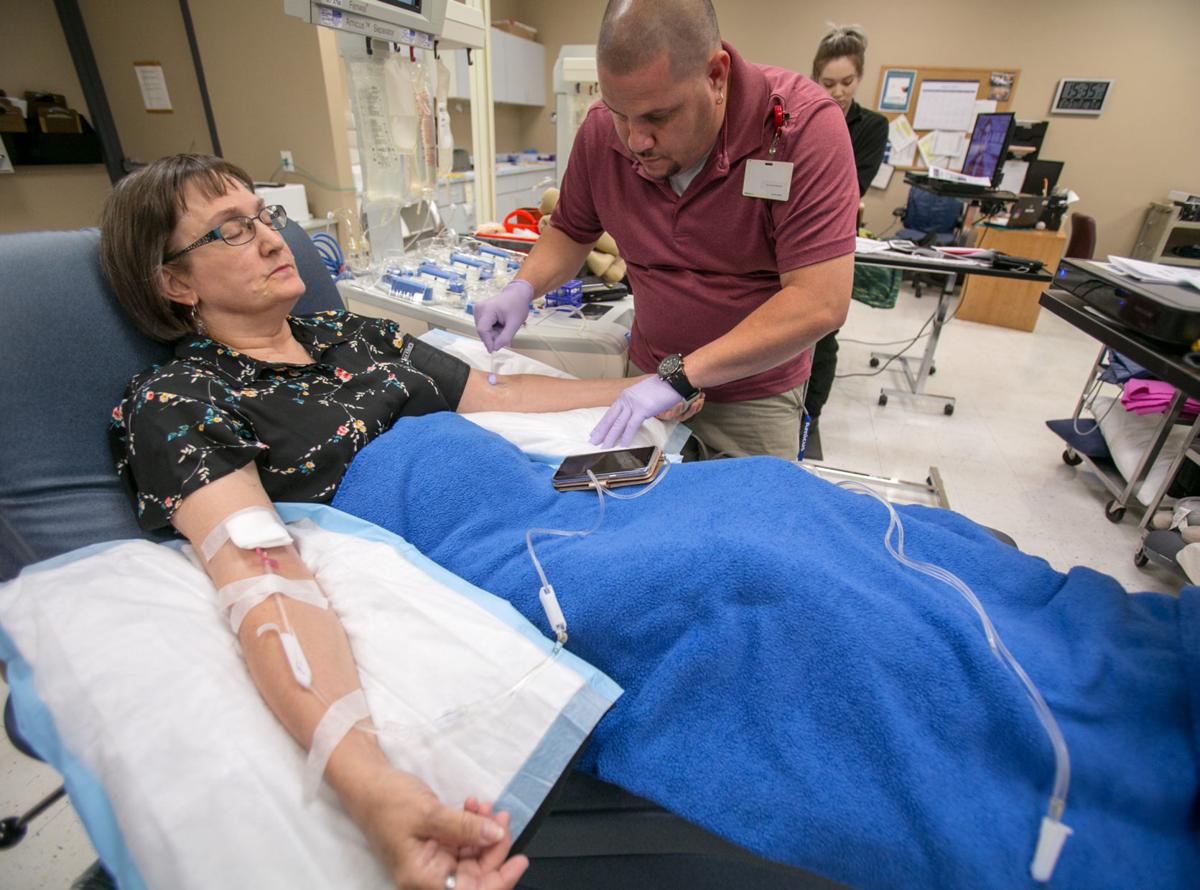Notes: This article first ran in 2018, but the need for blood and platelets is constant.
The Foothills Mall donation center has moved to 7354 N. La Cholla Blvd.
Robert Ochoa is no longer with the northwest donation center, but there are plenty of caring, capable people to take care of donors.
-
If you don’t know anyone who is in or has been through cancer treatment, or someone who has had major surgery, you are very lucky. And if you do have friends or family who have needed blood products, you know how important they are and how grateful the recipients are.
Cancer treatments often cause a decrease in patients’ platelets, which are needed to stop bleeding, so cancer patients are transfused with donated platelets to give them more clotting ability.
There is always a need for blood and platelets, yet the American Red Cross estimates only 10 percent of eligible donors do so on a regular basis.
When a call goes out because there is a critical shortage of blood or blood products, some who only donate sporadically may step up, as do many people when there is a tragedy like a mass shooting.
However, if more people who are eligible to donate did so on a regular basis, there wouldn’t be a critical shortage when such an incident happens. The blood and blood products that are used following a tragedy like a mass shooting are needed before the event happens. Donations after the fact are wonderful, but donations are needed constantly.

Before a needle can be inserted into the arm of a donor, a small area of the arm is cleaned with ChloraPrep, an antiseptic, for 30 seconds. The arm is then marked before insertion.
Giving blood is scary. But giving blood or platelets is a nearly painless way to perform a true act of charity.
The recipient won’t know who saved their life or quality of life. But you will have the knowledge that you don’t have to leap tall buildings in a single bound to be a hero. There’s no cape, but you’ll have a secret identity.
So who should donate blood and who should donate platelets? And what about plasma?
According to the Red Cross, those with O-negative blood are universal blood donors, and their blood can be transfused into those with any blood type. Because of this, they are encouraged to make whole blood donations because that will make the most impact. Those with B-negative blood are also encouraged to donate whole blood. Often those with O-positive blood are needed as whole blood donors as well. That blood type is the most common and can be transfused into anyone with rh-positive blood.
AB is the most rare blood type. People with type AB are universal plasma donors and are encouraged to donate plasma instead of whole blood. Plasma is used for treating those with bleeding disorders, immune deficiency disorders, burns and other problems. Plasma can be donated at the same time as platelets if the donation center used doesn’t offer plasma-only donations.
All others are encouraged to donate platelets, whole blood or both.
An individual may donate whole blood every eight weeks, or 56 days. Platelet donors may give every seven days, up to 24 times per year.
Donating a unit of whole blood takes about an hour and 15 minutes from start to finish. This includes the time for the donor to read the materials, provide their health history, and have their hemoglobin level checked before the actual donation. It will only take about 10 minutes to donate a pint of blood. Everything else that takes time is done to ensure the donor’s safety and the safety of the blood supply for the recipients.

Robert Ochoa fills out paperwork as Johanna Eubank’s blood moves to the Amicus Separator at the Red Cross Blood Donation Center in the Foothills Mall on March 27, 2018. The process, depending on the quantity of platelets can last about two hours.
I donated platelets recently and asked a lot of questions so I could give details of the process.
Beginning a few days before the scheduled donation, I began drinking extra water. Good hydration is always important in Tucson, but my perfectly selfish reason for being well hydrated is that it is easier for the attendant to find my veins for the needle stick. It also hurts less, but the pain is minimal at any time. I also eat a good meal before donating.
I went online before I left home to complete my RapidPass. This saves time at the donation center. To complete the RapidPass, I read all of the materials — it’s really best to read them all, they do change from time to time — and then answered the health questions online. I followed the instructions to get my QR code for use at the donation center.
I then went at my appointment time to the American Red Cross Donation Center at the Foothills Mall, 7325 N. La Cholla Blvd. I checked in and showed my donor card. If you are a first-time donor, you won’t have one and will need to have a photo ID.
Robert Ochoa, supervisor of operations in the apheresis department, took my blood pressure and did other health checks, asked me those intrusive questions like how much I weigh, and had me read and sign some things.
A platelet donation is made using an apheresis machine and can take about two hours, depending on your platelet count. I’m lucky, the normal count is about 150 — also the minimum needed for a donor — but my count is usually more than 350, so my donation takes a little less time than average or ─ even better ─ I donate three units instead of two.
Even so, I was at the donation center for three hours.
I was doing a double needle procedure. (A whole blood donation only requires one needle.) Whole blood is removed from one arm and run through the machine to remove some plasma and platelets.
Saline solution, the red blood cells and everything else except a bag of plasma and the platelets was returned to me in my other arm. The plasma is kept to help preserve the platelets.
Ochoa marked the best place on each arm to stick the needles and then cleaned each arm with ChloraPrep, an antiseptic, for 30 seconds before inserting the needle. I felt the needle pricks for about a second each and then was comfortable.
A small bag was filled with blood to be used for testing and then my blood was sent to the Amicus Separator to collect the platelets.
Meanwhile, Ochoa filled several vials with the test blood. Tests are performed every time a person donates to be sure the blood supply is safe. Sometimes you don’t know if you’ve been exposed to something.
All I had to do was sit and wait as the machine did the work and returned my filtered blood to me. I also had to keep my arms perfectly still. Most donors watch TV or a movie on their own little television with headphones while their donation is being collected. Imagine watching “Wonder Woman” while you are really being a wonder woman.
Sometimes, as what happened with me, the donor feels a little strange around the lips. I felt as if mine were buzzing. This is normal and goes away when the donation is over. Calcium helps.
Also normal is an intense desire for blankets. The anticoagulant and saline solution are at room temperature so they can cause the donor to get cold. Just ask for more blankets. They have plenty. Not everyone gets cold.
Once I was done, the needles were removed, bandages applied and red tape wrapped around my arms. I was told I could remove the red tape after an hour and the bandages after three hours.
After 10 minutes drinking orange juice and eating cookies in the snack area, I was ready to go. During that time, each person working in the area managed to thank me for my donation.
I was given instructions to follow if I had any soreness, bruising, dizziness or other problems. Most of these side effects are rare or go away quickly.
There was also an number I could call if I came down with the flu or something in the next couple of days because you can be contagious before you have symptoms.
My platelets were probably used within three days of the day they were collected, although they can last five days. And someone will be glad I took three hours out of my life to help a stranger.
Superman has nothing on blood and platelet donors who save lives all the time
Blood and platelet donation are practically painless ways to save lives
Updated
Daily Star reporter Johanna Eubank sits in a private interview room with Supervisor Robert Ochoa prior to donating platelets at the Red Cross Blood Donation Center in the Foothills Mall on March 27, 2018 in Tucson, AZ. All donors are required to go through an interview prior to making a donation. This process is speeded up if a Rapid Pass is completed online by the donor before going to the donation center. It includes reading the materials and answering the health questions.
Blood and platelet donation are practically painless ways to save lives
Updated
Technician Robert Ochoa enters information into the computer prior to Daily Star reporter Johanna Eubank's platelet donation at the Red Cross Blood Donation Center in the Foothills Mall on March 27, 2018 in Tucson, AZ. A platelet donation is made using an apheresis machine. With a double-needle procedure, whole blood is removed from one arm and run through the machine to remove the platelets. Saline solution and the red blood cells and everything else except a bag of plasma and the platelets are returned to the donor in the other arm. The bag of plasma is kept to help preserve the platelets.
Blood and platelet donation are practically painless ways to save lives
Updated
Collection vials are bar-coded in preparation for platelet donation at the Red Cross Blood Donation Center in the Foothills Mall on March 27, 2018 in Tucson, AZ.
Blood and platelet donation are practically painless ways to save lives
Updated
Robert Ochoa applies a blood pressure cuff to the donation arm of Daily Star reporter Johanna Eubank's right arm in preparation for platelet collection at the Red Cross Blood Donation Center in the Foothills Mall on March 27, 2018 in Tucson, AZ. According to American Red Cross representatives, if more of the people who are eligible to donate blood or platelets did so regularly, we might never hear of critical shortages during emergencies.
Blood and platelet donation are practically painless ways to save lives
Updated
A smaller needle is used for a platelet donation compared to a traditional whole blood donation so some donors find it to be more comfortable. Photo taken at the Red Cross Blood Donation Center in the Foothills Mall on March 27, 2018 in Tucson, AZ.
Blood and platelet donation are practically painless ways to save lives
Updated
Technician Robert Ochoa marks the right arm of Daily Star reporter Johanna Eubank in preparation for insertion of the needle that will return blood to her body after filtering out platelets at the Red Cross Blood Donation Center in the Foothills Mall on March 27, 2018 in Tucson, AZ. Before taking blood the technician must be assured they can successfully put it back.
Blood and platelet donation are practically painless ways to save lives
Updated
Robert Ochoa feels the vein of Daily Star reporter Johanna Eubank's right arm in preparation for insertion of the needle that will return blood to her body after filtering out platelets at the Red Cross Blood Donation Center in the Foothills Mall on March 27, 2018 in Tucson, AZ. Before taking blood the technician must be assured they can successfully put it back.
Blood and platelet donation are practically painless ways to save lives
Updated
With the return needle set in place, technician Robert Ochoa is assured blood will find its way back to the donor at the Red Cross Blood Donation Center in the Foothills Mall on March 27, 2018 in Tucson, AZ. The needle prick is felt for only a second. If there is pain after that, the donor should say so.
Blood and platelet donation are practically painless ways to save lives
Updated
Robert Ochoa swabs the donation arm of Daily Star reporter Johanna Eubank's left arm with a ChloraPrep Swabstick in preparation for insertion of the needle that will remove blood at the Red Cross Blood Donation Center in the Foothills Mall on March 27, 2018 in Tucson, AZ.
Blood and platelet donation are practically painless ways to save lives
Updated
Technician Robert Ochoa places the needle on the left arm of reporter Johanna Eubank in preparation for insertion of the needle that will remove blood to have platelets filtered out at the Red Cross Blood Donation Center in the Foothills Mall on March 27, 2018 in Tucson, AZ. The ring on her arm is the sterile edge where her arm was cleaned with a ChloraPrep Swabstick. Once the needle is in, the donor should barely feel it and it should not be painful at all.
Blood and platelet donation are practically painless ways to save lives
Updated
Technician Robert Ochoa draws off blood from a bypass line as donor blood makes its way to an Amicus Separator that collects platelets and returns the blood to the donor at the Red Cross Blood Donation Center in the Foothills Mall on March 27, 2018 in Tucson, AZ. Blood is tested every time a person donates to be sure the blood supply is safe. Sometimes a person doesn’t know he or she has been exposed to something.
Blood and platelet donation are practically painless ways to save lives
Updated
Robert Ochoa fills out paperwork as Johanna Eubank's blood moves to the Amicus Separator at the Red Cross Blood Donation Center in the Foothills Mall on March 27, 2018 in Tucson, AZ. The process, depending on the quantity of platelets can last about two hours. The donor must keep his or her arms still. No scratching or itchy noses allowed. But no worries, the technicians will scratch noses, change TV channels or whatever is required to help keep you comfortable.
Blood and platelet donation are practically painless ways to save lives
Updated
Multiple pumps move blood through the separator dividing it into its various components before returning it to the donor at the Red Cross Blood Donation Center in the Foothills Mall on March 27, 2018 in Tucson, AZ.
Blood and platelet donation are practically painless ways to save lives
Updated
Johanna Eubank relaxes as her blood completes a full circuit of donation, platelet harvesting and return at the Red Cross Blood Donation Center in the Foothills Mall on March 27, 2018 in Tucson, AZ. The process, depending on the quantity of platelets can last about two hours. Donors often watch television or movies.
Blood and platelet donation are practically painless ways to save lives
Updated
The separator monitors the platelet donation process including pressures in and out, quantity and duration at the Red Cross Blood Donation Center in the Foothills Mall on March 27, 2018 in Tucson, AZ.
Blood and platelet donation are practically painless ways to save lives
Updated
Robert Ochoa checks in with Johanna Eubank as her blood completes a full circuit of donation, platelet harvesting and return at the Red Cross Blood Donation Center in the Foothills Mall on March 27, 2018 in Tucson, AZ. The process, depending on the abundance of platelets can last about two hours. Donors often watch television or movies. Sometimes the donor feels a little strange around the lips, perhaps a buzzing feeling. This is normal and goes away when the donation is over. Calcium helps. Some donors also get cold because the anticoagulant and saline are not as warm as the body, but other donors don't have that problem. Red Cross workers will cover you with as many blankets as you desire.







